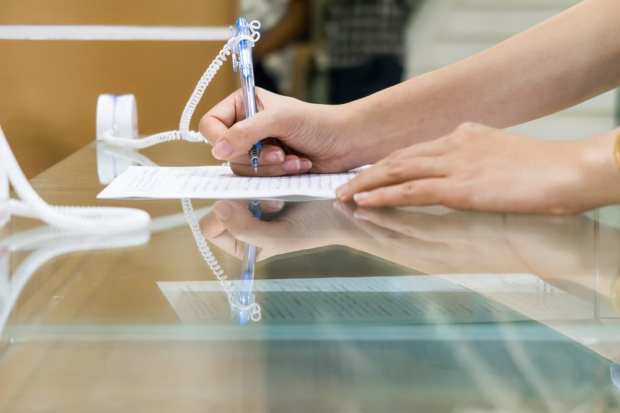Why Office Lobbies Are Saying Bye-Bye To Paper Logbooks

Look no further than the lobby of a typical office building for a glimpse of the living past — along with a potential vision of the digital future. Think about it.
Entry often involves the use of paper and pencil to log in, sometimes accompanied by the scribbling of one’s driver’s license number or other personal identification information (PII) on a paper log that’s maintained by a total stranger. That driver’s license could also be photocopied and stuck in a binder, accessible by just about anyone and everyone. That stranger is sometimes cheerful, giving off a trustful vibe — other times, that stranger is scowling, and can seem disgruntled. No matter what, though, the paper-based process takes time (that is, requires friction), and contrasts with the seamless, digitally focused experiences that office visitors are used to inside their homes, which are increasingly web-connected and voice-controlled.
As told by Larry Gadea, CEO and founder of Envoy, the office lobby — and the associated delivery and meeting areas — stands as one of the main fortresses of analog processes. However, those days could be numbered. As he discussed with Karen Webster in a new PYMNTS interview, the visitor management software firm is working hard to bring digital efficiencies to not only the lobby entry process, but a host of other manual tasks that remain part of daily office life.
“Logbooks and pens” are not ideal, Gadea said, joking about all those smudges on entry books, but really talking about the time wasted with such a process, and the security and privacy concerns associated with it. That’s not the only problem, either. “At the end of the day, it’s an experience problem,” he added, noting how an increasing number of people are not only used to the eCommerce and search experiences offered by the likes of Amazon, Google, Twitter and other online firms, but are living inside houses that are steadily being connected to the Internet of Things (IoT) ecosystem.
“You expect this great experience,” he explained, but when one visits an office or another place of business, it can be like one is forced back in time, where those digital experiences simply do not exist. Not only that, but all the information out in the open on paper logs presents privacy concerns for most people (perhaps not for visiting sales professionals, but competitive intelligence is not a priority for most people). “It’s a little silly to have all this information out in the open,” he told Webster.
More broadly, the idea behind Envoy is to take the paper-based, mundane, boring parts of office management and make them, in Gadea’s words, “something that’s interesting and exciting.” Lest one think that that’s some sort of hype, consider this: Not only do lobby check-ins involve security issues (for instance, the signing of non-disclosure agreements), but compliance can be at play, too, especially if there are safety factors to consider (such as when someone visits a manufacturer and must, by law, watch a safety video or agree to wear a hard hat). The general idea is to take care of all that via digital technology and tablet computers, instead of via paper-based recording methods.
The idea also goes well beyond checking in with lobby employees.
Take deliveries, for instance. Instead of waiting for mailroom employees to sort and distribute packages (or waiting anxiously on the next UPS or FedEx delivery), the digital technology at play can inform package recipients via email that their deliveries have finally arrived. Meetings and conferences could also be improved via an electronic system that enables more efficient bookings of those spaces. Not only does that take away the common office anxiety of figuring out which rooms are free for a gathering of employees, but it can provide more clarity to companies about how their spaces are being used — which, Gadea said, can help them better decide if they need to lease more office space.
Gadea, by all accounts, is a wunderkind who has worked for Google and Twitter (he was hired by Google after the company noticed his creative coding on a piece of Google software), and uses his own experiences as inspiration for his work at Envoy. He recalled with Webster his visits to companies where friends and colleagues worked, where he was struck by what he called the “arcane” process of paper logbooks, and the barely disguised theater of proving security via such methods. In addition, there was a good amount of confusion involved — what if the lobby agent wasn’t there, for instance?
Now, Envoy technology has been deployed by some 10,000 companies in more than 70 countries, with some 100,000 daily uses. Don’t think, though, that businesses offices or factories are the only places it is used. He told Webster that 18 percent of sign-ins via Envoy are in schools — not surprising, considering the increased security for educational institutions over the past generation.
The technology can also, in his words, make office visitors “feel like VIPs,” as the tablets could offer welcome messages in meeting rooms or other areas of the office (similar, say, to what happens at industry conferences and trade shows). “When a visitor comes in, that’s a big time to impress,” he said.
Of course, this is all happening at a time when more workers are working remotely — and in shared spaces. As Gadea explained, Envoy plans to keep abreast of those trends by providing more office management integrations and services for those specific situations — a move likely to involve the use of augmented reality and virtual reality to, say, enable brainstorming sessions and other types of meetings for workers often separated by great distances.
The main mission is pretty simple, though: to bring to offices the seamless, digital experiences that people are getting at home and in their daily lives as consumers. After all, Gadea said, “offices are super plagued by antiquated design patterns,” a situation that cries out for digital intervention.
